1998 JAGUAR X308 headrest
[x] Cancel search: headrestPage 2022 of 2490
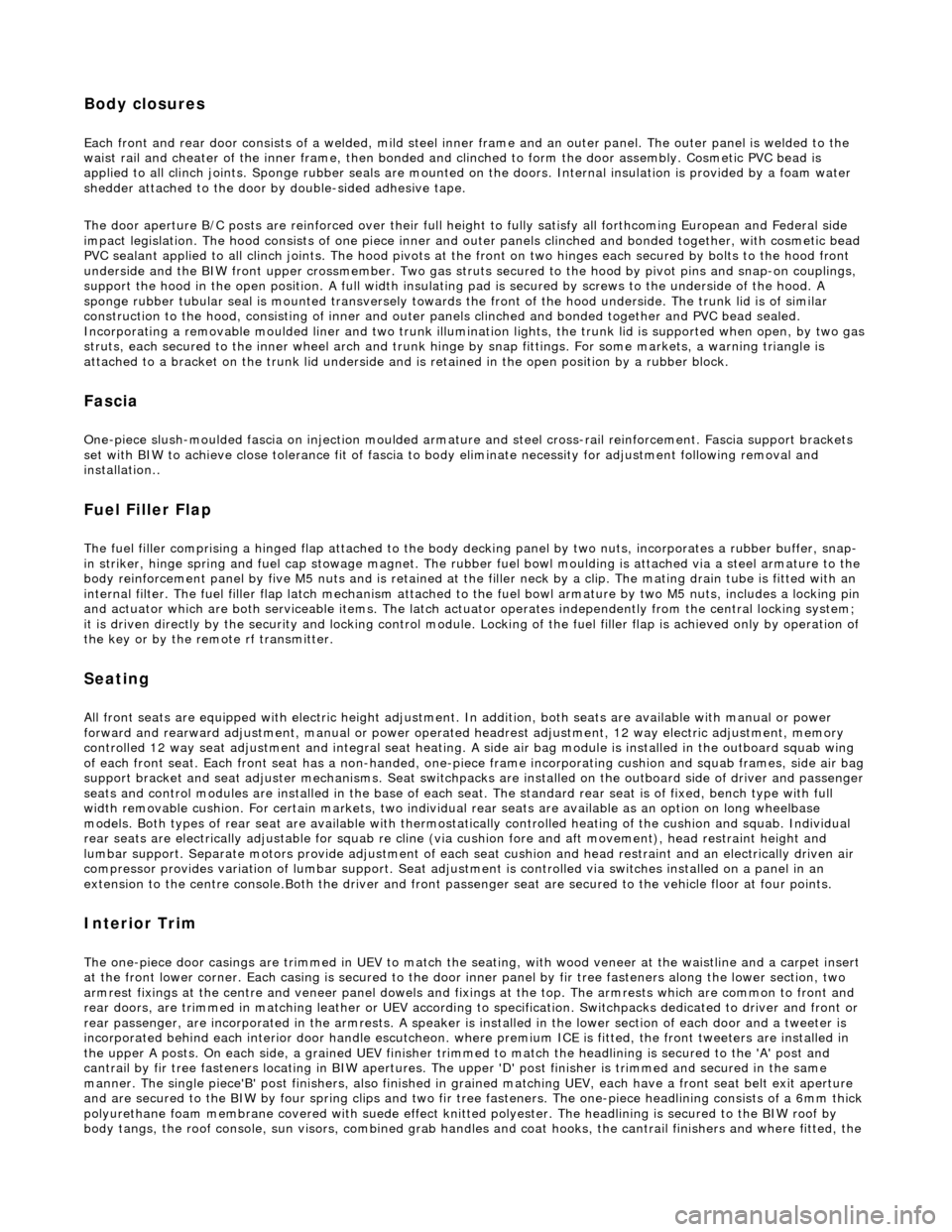
Body closures
Each front and rear door consists of a welded, mild steel inner frame and an outer panel. The outer panel is welded to the
waist rail and cheater of the inner frame, then bonded and clinched to fo rm the door assembly. Cosmetic PVC bead is
applied to all clinch joints. Sp onge rubber seals are mounted on the doors. Inte rnal insulation is provided by a foam water
shedder attached to the door by double-sided adhesive tape.
The door aperture B/C posts are reinforced over their full height to fully satisfy all forthcoming European and Federal side
impact legislation. The hood consists of one piece inner and outer panels clinched and bonded together, with cosmetic bead
PVC sealant applied to all clinch joints. Th e hood pivots at the front on two hinges each secured by bolts to the hood front
underside and the BIW front upper crossmem ber. Two gas struts secured to the hood by pivot pins and snap-on couplings,
support the hood in the open position. A full width insulating pad is secured by screws to the underside of the hood. A
sponge rubber tubular seal is mounted tran sversely towards the front of the hood underside. The trunk lid is of similar
construction to the hood, consisting of inner and outer pa nels clinched and bonded together and PVC bead sealed.
Incorporating a removable moulded liner and two trunk illuminati on lights, the trunk lid is supported when open, by two gas
struts, each secured to the inner wheel arch and trunk hinge by snap fittin gs. For some markets, a warning triangle is
attached to a bracket on the trunk lid underside and is retained in the open position by a rubber block.
Fascia
One-piece slush-moulded fascia on inject ion moulded armature and steel cross-rail reinforcement. Fascia support brackets
set with BIW to achieve close tolerance fit of fascia to bo dy eliminate necessity for adjustment following removal and
installation..
Fuel Filler Flap
The fuel filler comprising a hinged flap attached to the body decking panel by tw o nuts, incorporates a rubber buffer, snap-
in striker, hinge spring and fuel cap stowage magnet. The rubber fuel bowl moulding is attached via a steel armature to the
body reinforcement panel by five M5 nuts and is retained at the filler neck by a clip. The mating drain tube is fitted with an
internal filter. The fuel filler flap latch mechanism attached to the fuel bowl armatu re by two M5 nuts, includes a locking pin
and actuator which are both se rviceable items. The latch actuator operates independently from the central locking system;
it is driven directly by the se curity and locking control module. Locking of the fuel filler flap is achi eved only by operation of
the key or by the remote rf transmitter.
Seating
All front seats are equipped with electric height adjustment. In addition, both seats are available with manual or power
forward and rearward adjustment, manual or power operated headrest adjustment, 12 way electric adjustment, memory
controlled 12 way seat adjustment and integral seat heating. A side air bag module is installe d in the outboard squab wing
of each front seat. Each front seat has a non-handed, one-piece frame incorporatin g cushion and squab frames, side air bag
support bracket and seat adjuster mechanis ms. Seat switchpacks are installed on the outboard side of driver and passenger
seats and control modules are installed in the base of each seat . The standard rear seat is of fixed, bench type with full
width removable cushion. For certain mark ets, two individual rear seats are available as an option on long wheelbase
models. Both type s of rear seat are available with th ermostatically controlled heating of the cushion and sq uab. Individual
rear seats are electrically adjustable fo r squab re cline (via cushion fore and af t movement), head restraint height and
lumbar support. Separate motors provide ad justment of each seat cushion and head restraint and an electrically driven air
compressor provides variation of lumbar support. Seat adjustment is controlled via switches installed on a panel in an
extension to the centre console.Both the driver and front pass enger seat are secured to the vehicle floor at four points.
Interior Trim
The one-piece door casings are trimmed in UEV to match the seating, with wood veneer at the waistline and a carpet insert
at the front lower corner. Each casing is secured to the door inner panel by fir tree fastener s along the lower section, two
armrest fixings at the centre and veneer panel dowels and fixings at the top. The armrests which are common to front and
rear doors, are trimmed in matc hing leather or UEV according to specification. Switchpacks dedicated to driver and front or
rear passenger, are incorporated in the ar mrests. A speaker is installed in the lower section of each door and a tweeter is
incorporated behind each interior door handle escutcheon. where premium ICE is fitted, the front tweeters are installed in
the upper A posts. On each side, a graine d UEV finisher trimmed to match the head lining is secured to the 'A' post and
cantrail by fir tree fasteners locating in BIW apertures. Th e upper 'D' post finisher is trimmed and secured in the same
manner. The single piece'B' post finishers, also finished in grained matching UEV, each have a front seat belt exit aperture
and are secured to the BIW by four spring clips and two fir tree fasteners. The one-piece headlining consists of a 6mm thick
polyurethane foam membrane covered with suede effect knitted polyester. The headlining is secured to the BIW roof by
body tangs, the roof console, sun visors, combined grab handles and coat hooks, th e cantrail finishers and where fitted, the
Page 2121 of 2490
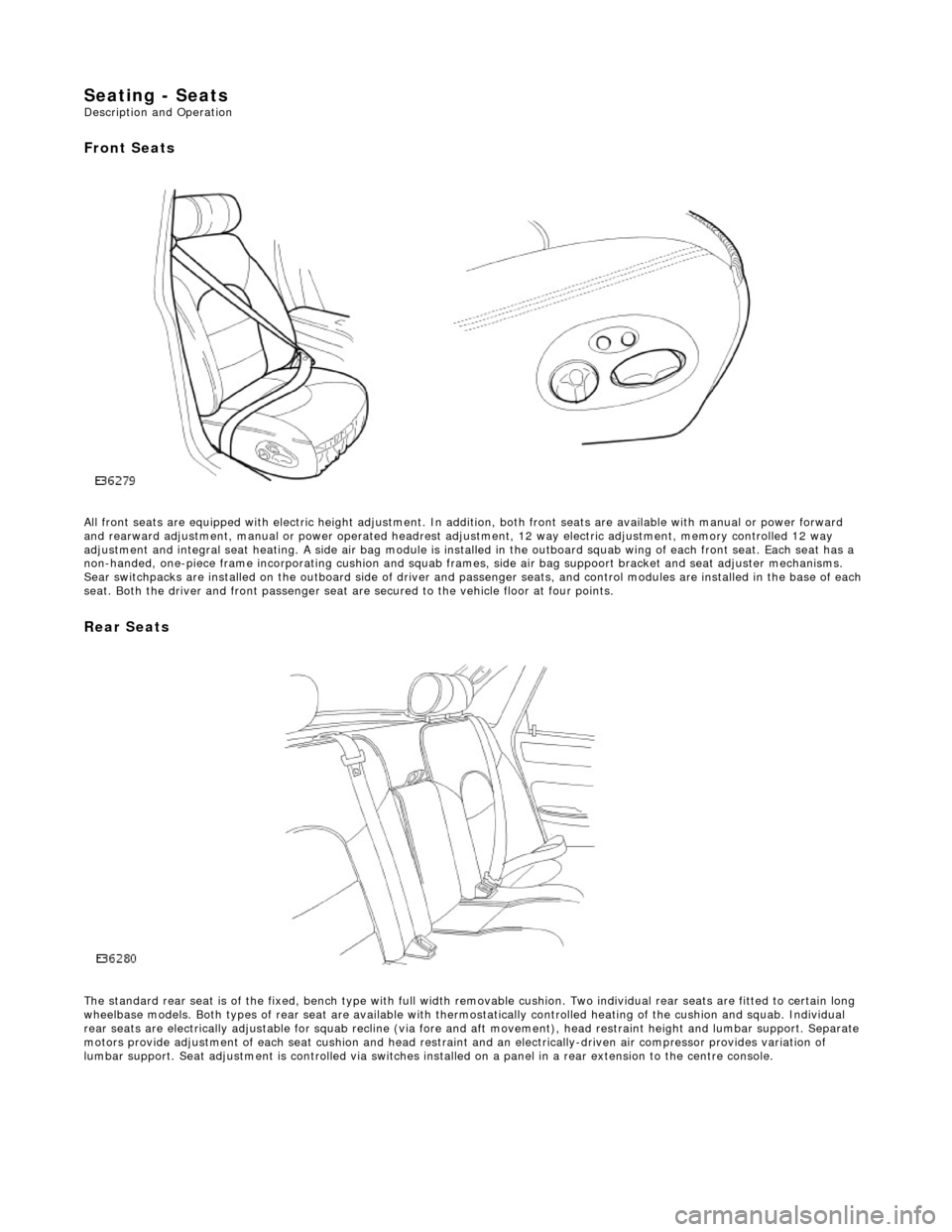
Seating - Seats Description and Operation
Front Seats
All front seats are equipped with electric height adjustment. In addition, both front seats are available with manual or power forward
and rearward adjustment, manual or powe r operated headrest adjustment, 12 way elec tric adjustment, memory controlled 12 way
adjustment and integral seat heating. A side air bag module is installed in the outboard squab wing of each front seat. Each se at has a
non-handed, one-piece frame incorporating cushion and squab frames , side air bag suppoort bracket and seat adjuster mechanisms.
Sear switchpacks are installed on the outboa rd side of driver and passenger seats, and control modules are installed in the bas e of each
seat. Both the driver and front passenger seat ar e secured to the vehicle floor at four points.
Rear Seats
The standard rear seat is of the fixed, bench type with full wi dth removable cushion. Two individual rear seats are fitted to certain long
wheelbase models. Both types of rear seat are available with thermostatically controlled heating of the cushion and squab. Indi vidual
rear seats are electrically adjustable for squab recline (via fore and aft moveme nt), head restraint height and lumbar support. Separate
motors provide adjustment of each seat cushion and head restraint and an electrica lly-driven air compressor provides variation of
lumbar support. Seat adjustment is controll ed via switches installed on a panel in a rear extension to the centre console.
Page 2124 of 2490

Seating - Front Seat Backrest
Removal and Installation
Removal
1. Remove front seat for ac cess. Refer to 76.70.01.
2. Remove seat back fini sher. Refer to 76.70.09.
3. Remove front seat headrest. Refer to 76.70.14.
4. Release the five squab cover to seat frame securing strips.
5. Release the squab cover to seat frame lower securing clips.
6. Remove the four squab pad to squab suspension hog rings.
7. Sever the two ratchet straps securing squab pad to squab
suspension.
Page 2125 of 2490
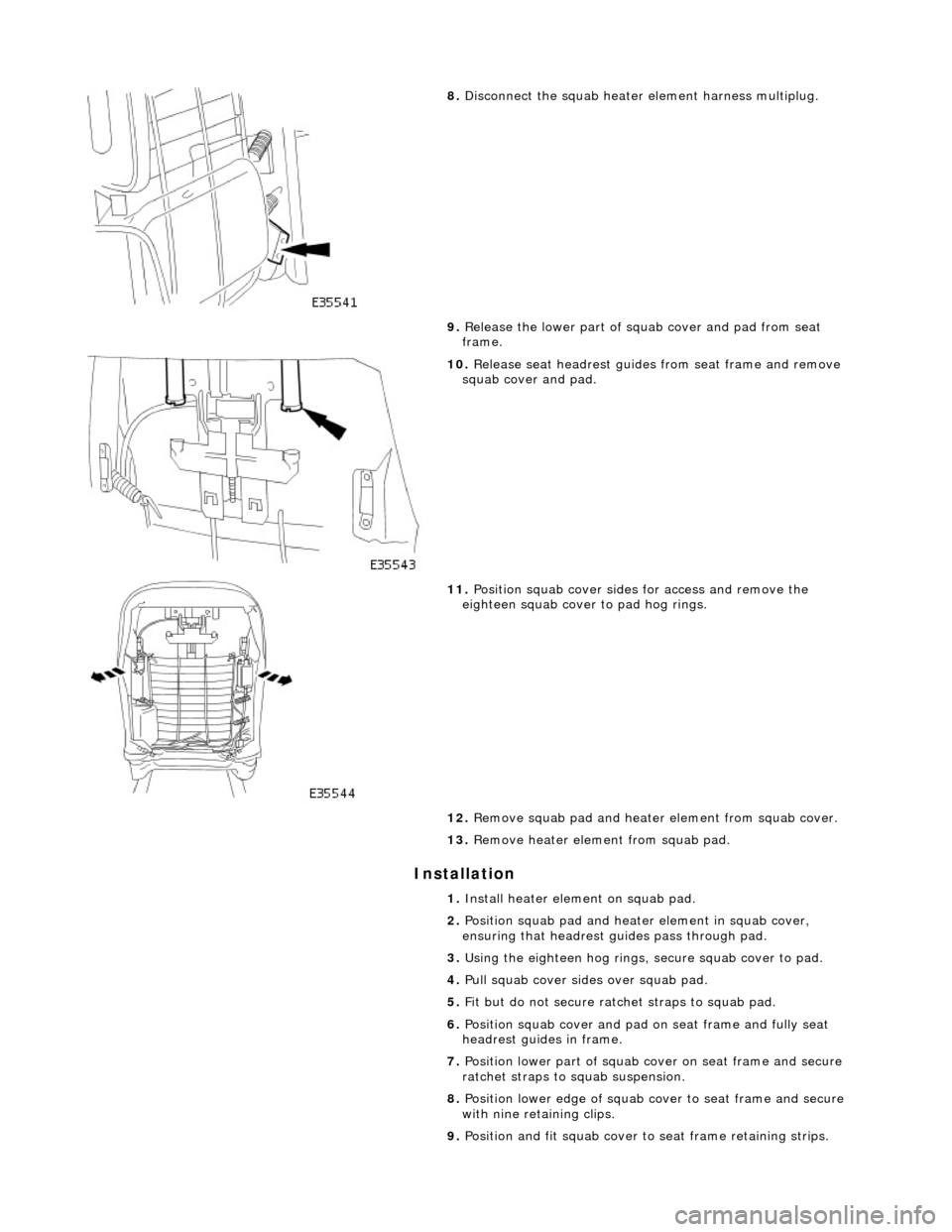
Installation
8. Disconnect the squab heater element harness multiplug.
9. Release the lower part of squab cover and pad from seat
frame.
10. Release seat headrest guides from seat frame and remove
squab cover and pad.
11. Position squab cover sides for access and remove the
eighteen squab cover to pad hog rings.
12. Remove squab pad and heater element from squab cover.
13. Remove heater element from squab pad.
1. Install heater element on squab pad.
2. Position squab pad and heater element in squab cover,
ensuring that headrest gu ides pass through pad.
3. Using the eighteen hog rings, secure squab cover to pad.
4. Pull squab cover sides over squab pad.
5. Fit but do not secure ratc het straps to squab pad.
6. Position squab cover and pad on seat frame and fully seat
headrest guides in frame.
7. Position lower part of squab co ver on seat frame and secure
ratchet straps to squab suspension.
8. Position lower edge of squab co ver to seat frame and secure
with nine retaining clips.
9. Position and fit squab cover to seat frame retaining strips.
Page 2126 of 2490
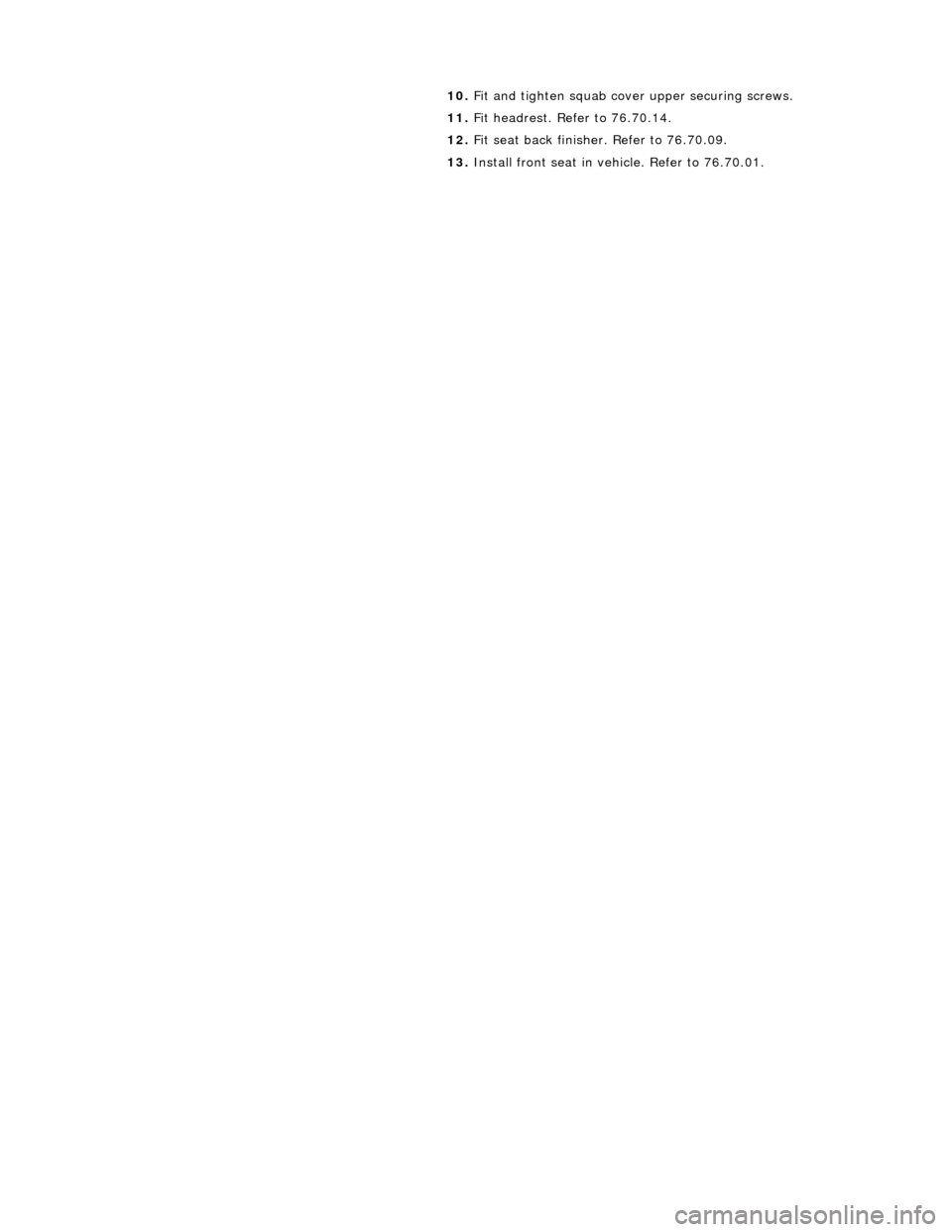
10.
Fit and tighten squab cover upper securing screws.
11. Fit headrest. Refer to 76.70.14.
12. Fit seat back finisher. Refer to 76.70.09.
13. Install front seat in vehi cle. Refer to 76.70.01.
Page 2127 of 2490
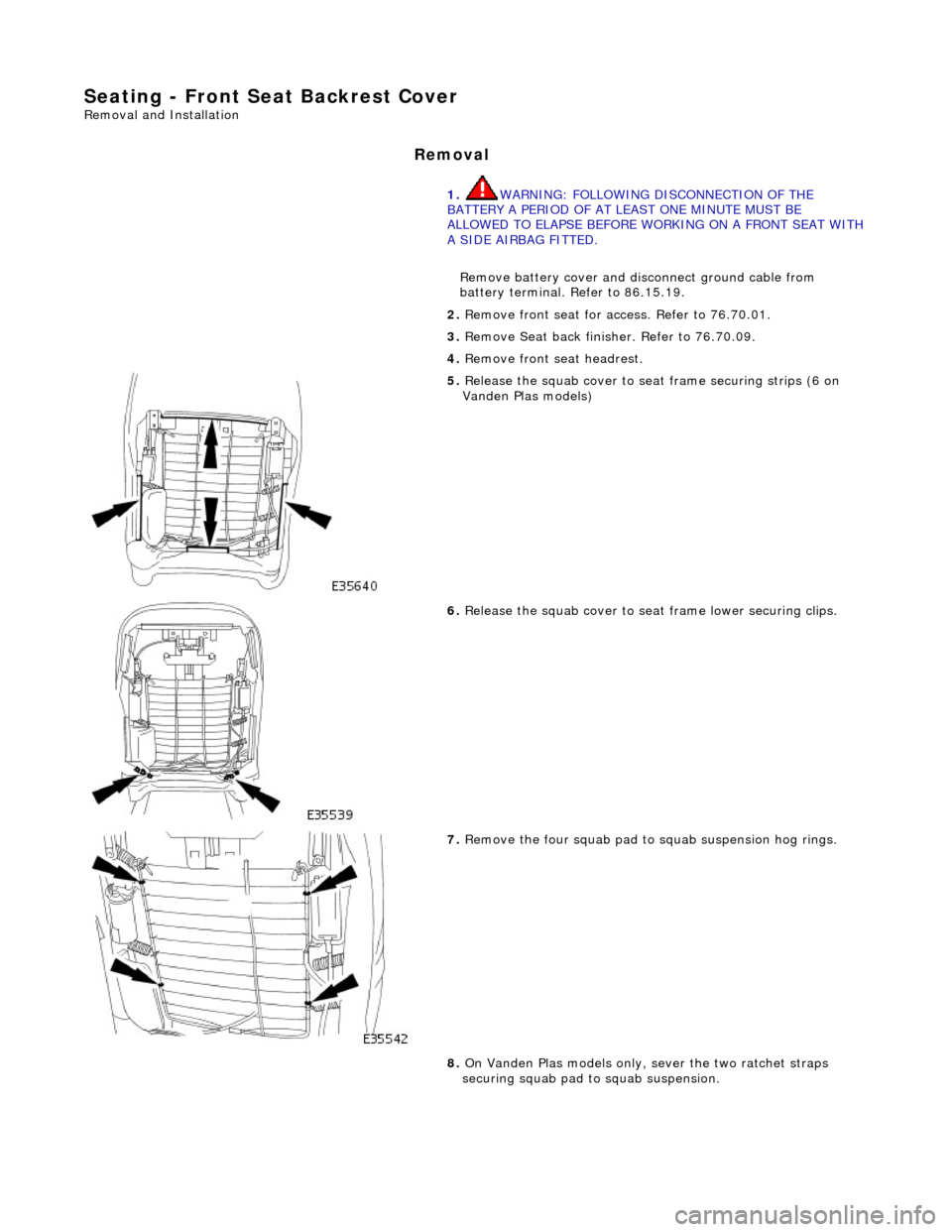
Seating - Front Seat Backrest Cover
Removal and Installation
Removal
1. WARNING: FOLLOWING DISCONNECTION OF THE
BATTERY A PERIOD OF AT LEAST ONE MINUTE MUST BE
ALLOWED TO ELAPSE BEFORE WORKING ON A FRONT SEAT WITH
A SIDE AIRBAG FITTED.
Remove battery cover and disc onnect ground cable from
battery terminal. Refer to 86.15.19.
2. Remove front seat for ac cess. Refer to 76.70.01.
3. Remove Seat back finisher. Refer to 76.70.09.
4. Remove front seat headrest.
5. Release the squab cover to seat frame securing strips (6 on
Vanden Plas models)
6. Release the squab cover to seat frame lower securing clips.
7. Remove the four squab pad to squab suspension hog rings.
8. On Vanden Plas models only, sever the two ratchet straps
securing squab pad to squab suspension.
Page 2128 of 2490
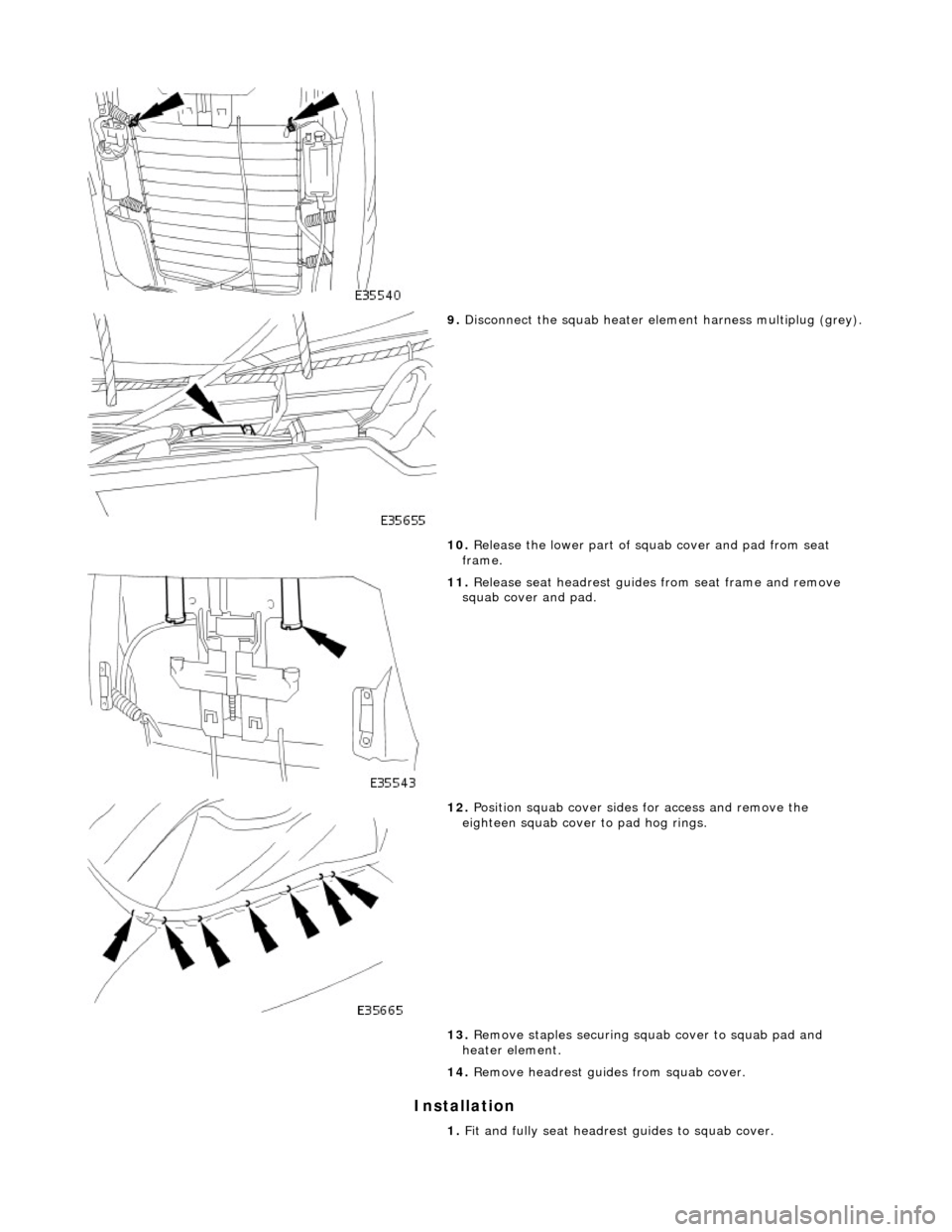
Installation
9. Disconnect the squab heater element harness multiplug (grey).
10. Release the lower part of squab cover and pad from seat
frame.
11. Release seat headrest guides from seat frame and remove
squab cover and pad.
12. Position squab cover sides for access and remove the
eighteen squab cover to pad hog rings.
13. Remove staples securing squab cover to squab pad and
heater element.
14. Remove headrest guid es from squab cover.
1. Fit and fully seat headrest guides to squab cover.
Page 2129 of 2490
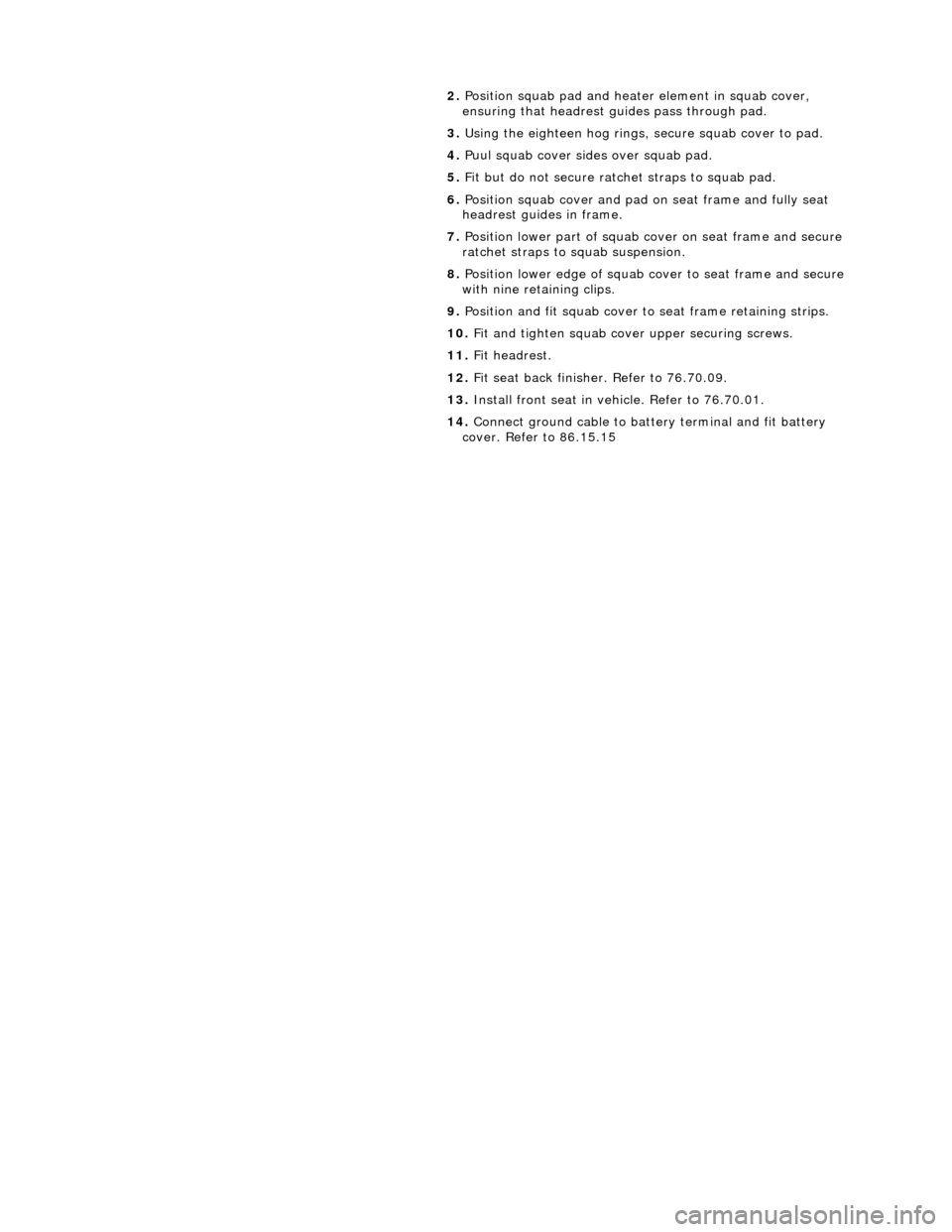
2.
Position squab pad and heater element in squab cover,
ensuring that headrest gu ides pass through pad.
3. Using the eighteen hog rings, secure squab cover to pad.
4. Puul squab cover sides over squab pad.
5. Fit but do not secure ratc het straps to squab pad.
6. Position squab cover and pad on seat frame and fully seat
headrest guides in frame.
7. Position lower part of squab co ver on seat frame and secure
ratchet straps to squab suspension.
8. Position lower edge of squab co ver to seat frame and secure
with nine retaining clips.
9. Position and fit squab cover to seat frame retaining strips.
10. Fit and tighten squab cover upper securing screws.
11. Fit headrest.
12. Fit seat back finisher. Refer to 76.70.09.
13. Install front seat in vehi cle. Refer to 76.70.01.
14. Connect ground cable to batt ery terminal and fit battery
cover. Refer to 86.15.15